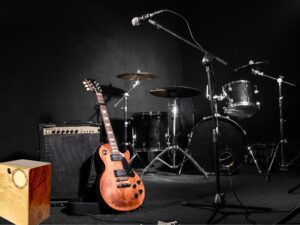

The flamenco cajón has become a symbol of Spain and is gaining more and more prominence on the national and international scene. It has become an indispensable percussion instrument as an accompaniment in flamenco, a Spanish musical genre that developed in Andalusia and is now famous worldwide. The history of the cajón is exciting and full of nuances, which is why we are eager to tell you about the origins of this wonderful instrument in our +íon percussion blog article.
Where did the flamenco cajón originate?
The flamenco cajón is originally from Peru. It was introduced by African slaves during the Spanish colonization of America in the 17th century, when they used wooden boxes intended for the transport of merchandise to help them accompany their songs, feel free and forget for a moment the ordeal they had lived through. That act of rebellion led to what was then called the Peruvian cajon.
Many years later, it was Paco de Lucía who took it to Spain, seduced by the sound of the instrument after a tour of the Inca country in 1977 and advised by his colleagues Rubem Dantas and Manuel Soler. By adding the internal strings, he catapulted it to another level, to the point that it became an essential part of the flamenco music tradition up to the present day. Until then, it was not customary to use percussion in the flamenco style, beyond clapping or hitting the guitar. But the cajón quickly adapted to join the party of dancing, singing, guitar, clapping, tapping and are forms of all kinds.
Francisco Sánchez Gómez, better known as Paco de Lucía, was a Spanish musician and composer considered the best flamenco guitarist of all time. Paco has always expressed his gratitude to Peru and especially to Carlos ‘Caitro’ Soto de la Colina, a prominent Afro-Peruvian cajon player and singer-songwriter, whose musical works have toured the world and have been performed by prominent international singers.
Why did the Peruvian cajón captivate Paco de Lucía?
Paco de Lucía arrived in Lima to attend a party, where he was honored by the Spanish ambassador in Peru Juan Ignacio Luca de Tena. The event was attended by several diplomats and featured a concert by the renowned Peruvian artist María Isabel Granda y Larco, artistically known as ‘Chabuca Granda’, with whom Caitro Soto played the cajón: “When I saw him with the cajón I thought it was our instrument, I saw it very clearly. Because it’s like the feet of a dancer; the bass is the sole of the foot and the treble is the heel. Plus you can take it everywhere, it was perfect. The cajón has been wonderful for flamenco and all kinds of musical styles”, declared Paco de Lucía in a documentary.
Later, Paco bought a cajón from Caitro and gave it to Rubem Dantas, a world-famous Brazilian percussionist, who was quickly seduced by the instrument and began to practice with it. When they returned to Spain, they premiered it at a concert in an amusement park with a large open-air theater and from there the success of the cajón was resounding, quickly becoming the percussion of choice for flamenco guitarists (with the addition of the strings inside to enhance the sound). Juan ‘Colito’ Medrano, Leonardo ‘Gigio’ Parodi, Freddy ‘Huevito’ Lobatón, Manuel ‘Mangüe’ Vásquez, Rafael Santa Cruz and Israel “Piraña” Suárez were some of those who would make the flamenco cajón known to the world.
The +íon cajon: The next step in the evolution of the cajon
Now, the cajon continues to evolve and break boundaries. From Alicante (Spain) the +íon cajon has arrived and is here to stay. What at first was an idea, a dream, has come to fruition, developed with a great respect and admiration for the instrument’s history and its players to date. However, the time was ripe for our fusion of tradition and innovation; to open up new possibilities and enter a new era.
With the addition of the strings inside, the Peruvian cajon became the flamenco cajon. Now, with the addition of interchangeable and tunable heads on its sides… the +íon cajón is its new brother. An unprecedented step: the only cajon in the world with drum heads. The incorporation of the ions makes multiple rhythmic possibilities available to the percussionist, so that he can easily adapt to any musical style, with a totally unique system.
Each drum head generates a particular sound quality, which conjures up different cultures and countries. For this reason, the interplay between the ions and the face plate of the cajon provides that personal touch that distinguishes the musician. In addition, the ease of transporting it makes life easier for the musician who wants to bring different kinds of percussion instruments with them, without taking up too much space – a great advantage that Paco de Lucía highlighted from the original Peruvian cajón. Now, with any of the seven drum head models that we offer at +íon percussion, you will also have several instruments in one.
Do you want to be part of the cajon revolution? Think outside the box and explore the various possibilities offered by each +ion cajon model and the interchangeable heads that you like the most. We can send it right to your home so that you can take part in the new era of cajons. Take a chance… nothing will ever be the same again!
We use cookies to ensure that we give you the best experience on our website. If you continue to use this site we will assume that you are happy with it.
2 Responses
I was excited to uncover this great site. I need to to thank you for your time for this particularly wonderful read!! I definitely enjoyed every part of it and I have you book marked to check out new stuff in your web site.
Everything is very open with a precise description of the issues. It was really informative. Your website is very helpful. Many thanks for sharing!